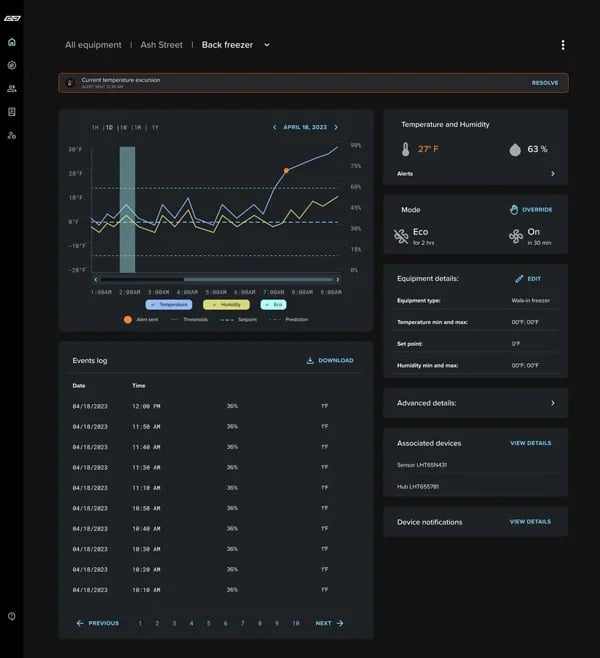Energy Optimization: A Culinary Revolution and More Than Just a Trend

The restaurant industry has been experiencing a significant shift toward energy optimization. This is not just a trend—it’s a revolutionary movement with multiple benefits for restaurants.
It’s crucial for restaurant owners to be aware of this revolution so they can make decisions that will ultimately benefit both their bottom line, the environment, and the overall sustainability of the business.
The Growing Imperative of Energy Optimization
Energy optimization is becoming a significant trend due to rising energy costs and growing environmental concerns. The International Energy Agency (IEA) emphasizes that doubling the global pace of energy efficiency progress by 2030 is crucial in reaching net-zero emissions.
The IEA also highlights that energy efficiency can notably reduce greenhouse gas emissions, direct emissions from fossil fuel combustion or consumption, and indirect emissions reductions from electricity generation. High energy prices have raised concerns about the risks energy price shocks pose for firms' performance and the green transition.
Energy optimization is achieved when you use the least utility-supplied energy and pay the lowest price possible. The U.S. Environmental Protection Agency's ENERGY STAR program guides how to save energy and money and protect the environment.
The global energy as a service market was valued at USD 59.37 billion in 2020 and is expected to grow at a compound annual growth rate (CAGR) of 8.9% from 2021 to 2028. Energy optimization is not just a trend but a necessity in the face of rising energy costs and environmental concerns.

7 benefits of energy optimization for restaurant optimization
1. Managing costs becomes easier with energy optimization
Restaurants can reduce overheads by optimizing energy use through initiatives like motion sensor lighting and high-efficiency kitchen equipment. Precision-controlled refrigeration also saves energy and inventory costs by reducing food spoilage. By implementing energy-efficient practices, restaurants can save money and allocate resources to other essential business aspects.
2. Restaurants can play a significant role in environmental conservation
While restaurants already have a profound ecological impact, implementing energy-saving practices can elevate them to become forward-thinking environmental stewards. After all, every kilowatt-hour saved contributes to a more sustainable planet. Involvement in this revolution positions restaurants as leaders in a global green movement, fostering trust and admiration from the community.
3. Gaining eco-conscious prestige attracts modern consumers
Restaurants have the potential to become environmentally responsible establishments that align with the values of modern consumers. Wearing an eco-friendly badge can attract customers and cultivate their loyalty. Patrons who value sustainability will appreciate the restaurant's efforts to reduce environmental impact.
4. Innovative approaches set restaurants apart
Integrating age-old culinary traditions with cutting-edge technology exemplifies innovation and creates modern-day artistry. Tools that provide data-driven insights into energy consumption combined with artificial intelligence systems that adapt to dining patterns can also enhance the dining experience. What does this mean? Restaurants can create unique dining experiences that will differentiate them from their competitors.
5. Efficient equipment leads to consistent culinary delivery
High-performance, energy-efficient appliances deliver with minimal disruptions, reducing operational strain and leading to fewer breakdowns. This reliability pays dividends, allowing chefs and kitchen staff to focus on crafting exquisite dishes that captivate the palates. Restaurants can ensure their operations run smoothly, allowing them to focus on what they do best—creating delicious food.
6. Financial incentives from governments can further increase savings
Governments and utility providers offer enticing rebates and incentives, recognizing businesses' pivotal role in sustainable goals. These financial perks can significantly offset initial investments, making the shift to energy-efficient models a compelling proposition. Talk about being able to save money and reduce environmental impact simultaneously.
7. A better staff experience is achieved through energy optimization
Lastly, an energy-optimized workspace enhances the staff experience by improving comfort levels. A harmonious, motivated team forms the backbone of a thriving restaurant, ensuring that every diner leaves with a good experience. An improved work environment can help restaurant owners boost employee morale and create a positive workplace culture.
Optimizing energy usage is a game-changer for restaurants. By implementing energy-efficient practices, restaurants can save money, reduce their environmental impact, and enhance the dining experience for their customers.
This revolution is more than a temporary trend
GlacierGrid is a pioneering solution that can help restaurants navigate the path toward sustainability. With smart cooling technology, restaurant leaders can craft a sustainable and prosperous narrative that sets them apart from their competitors—book a demo now.



References:
- International Energy Agency. "Doubling global pace of energy efficiency progress by 2030 is key step in efforts to reach net zero emissions." IEA, 7 June 2023
- International Energy Agency. "Emissions savings – Multiple Benefits of Energy Efficiency – Analysis." IEA, 19 Sept. 2023
- Organisation for Economic Co-operation and Development. "Rising energy prices and productivity: short-run pain, long-term gain?" OECD, 11 May 2023
- A1 Energy. "2023 Roadmap to Energy Optimization." A1 Energy, 16 Jan. 2023
- United States Environmental Protection Agency. "Reduce the Environmental Impact of Your Energy Use." EPA
- Grand View Research. "Energy as a Service Market Size, Share & Trends Analysis Report By Service Type, By End Use, By Region And Segment Forecasts, 2023 - 2030." Grand View Research, 2023








.jpg)